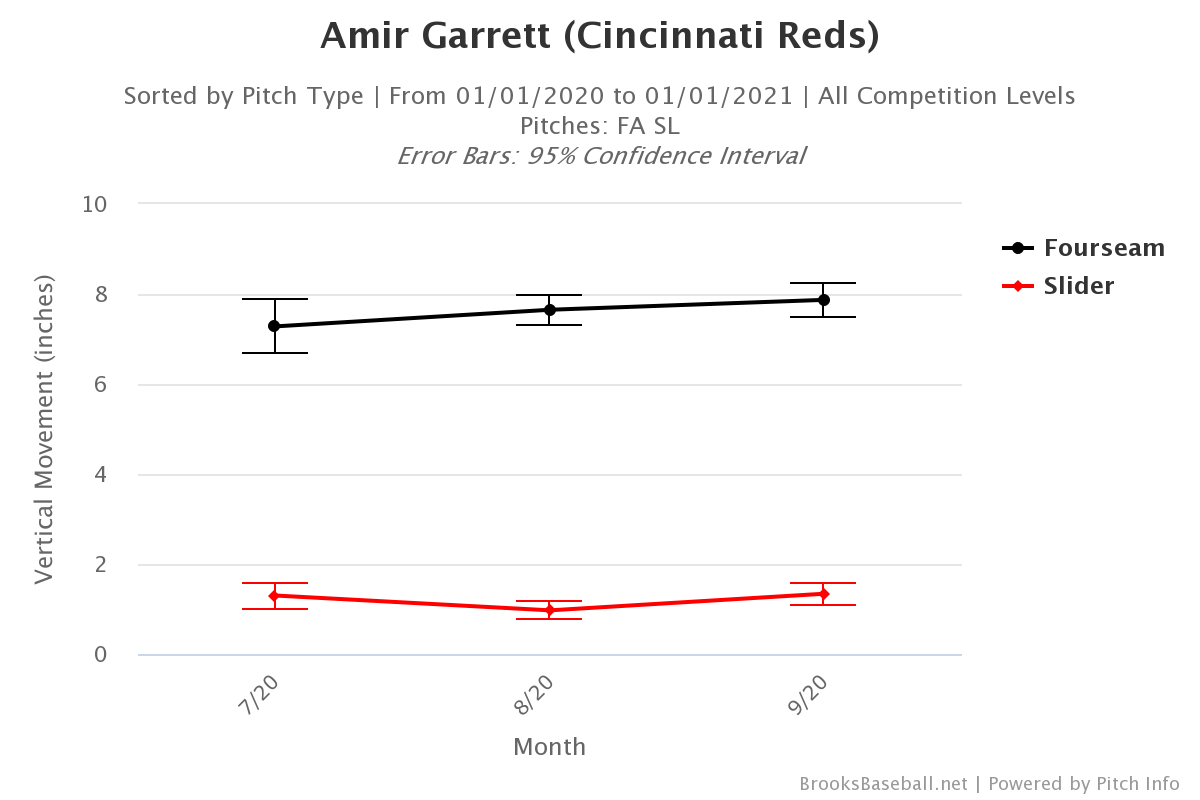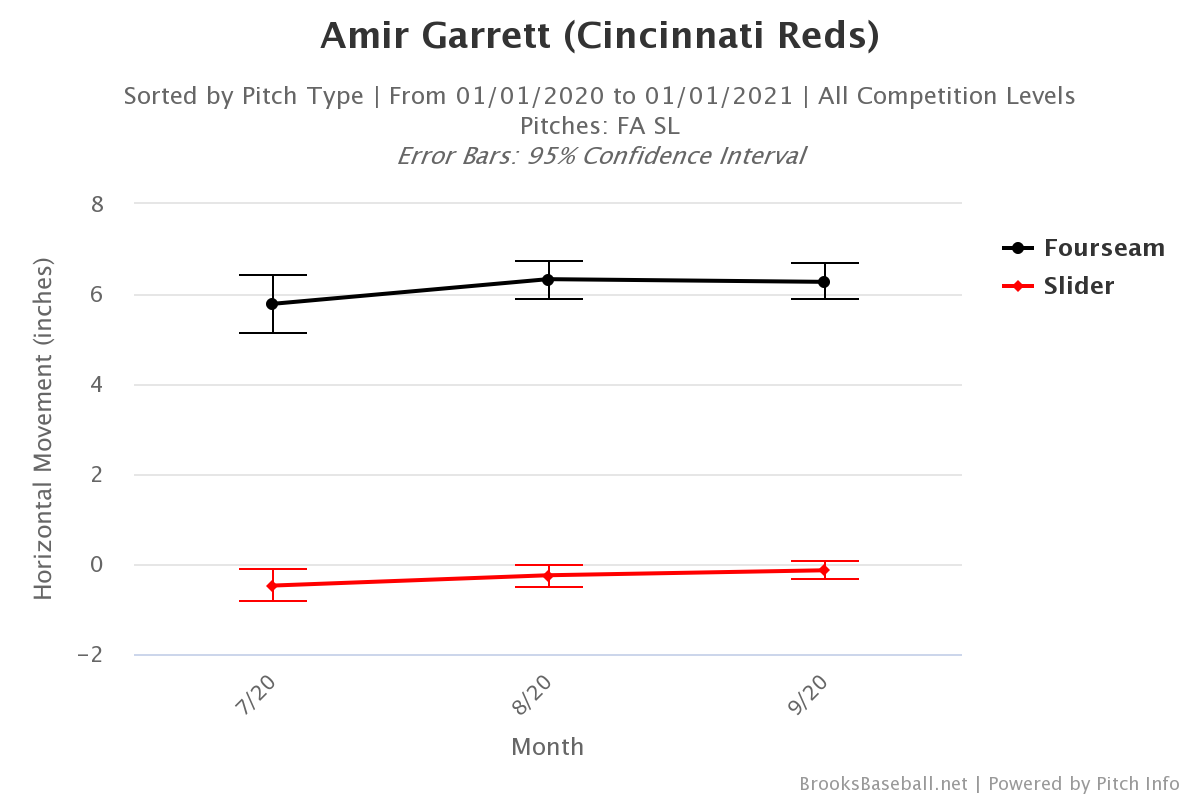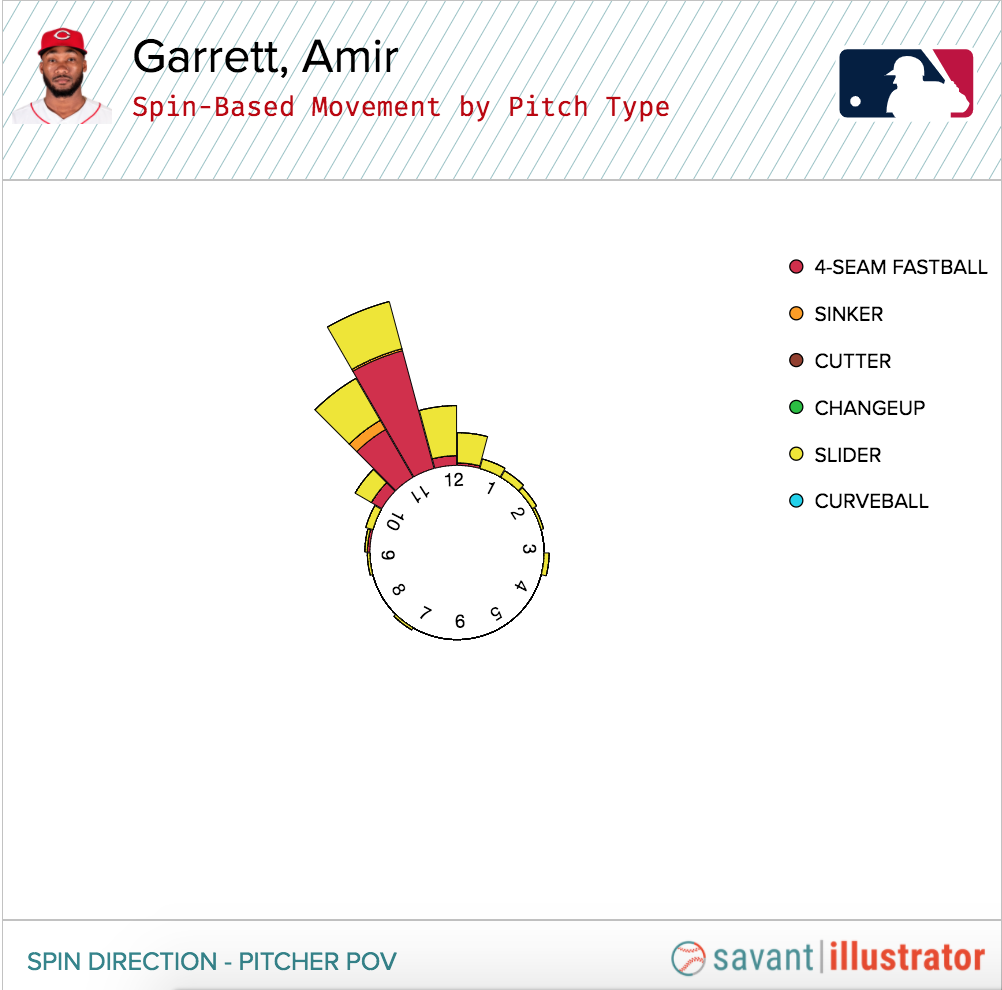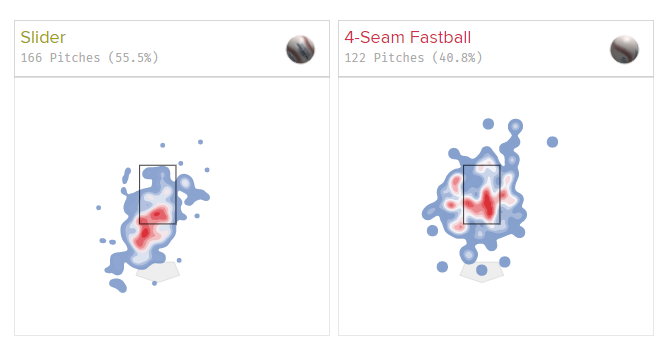We are living in the era of spin rate. The research is thorough, the results are clear, and the process is being embraced. Front offices, player development staffs, and even MLB pitchers themselves are all buying into high spin rates on fastballs and breaking pitches. So, when Amir Garrett sent out this tweet, it got me thinking.
Kid says to me, Amir how do I get my spin rate up on my pitches. I immediately look at him and say kid Idk. I know zero about that. Are coaches really preaching to kids about spin rate? Instead of competing. What good is spin rate if you can’t get outs? I’ve always wondered that.
— CountOnAG (@Amir_Garrett) December 21, 2020
While the innate ability to compete is without a doubt immensely important for most, if not all, players to find success on the field, that isn’t my takeaway from the tweet. Instead, it’s Garrett’s lack of appreciation, or perhaps misunderstanding, of spin rate. Of course, spin rate isn’t the end-all-be-all to pitching, and it doesn’t make or break a pitcher in a vacuum. But with an overwhelming amount of evidence to support the effectiveness of high spin rate, I couldn’t help but wonder why a MLB pitcher, let alone one that pitches for a club that openly embraces pitching analytics, could downplay its usefulness. Garrett’s main focus might solely be on competing with every pitch he throws, but it’s probably plausible that he shys away from the “high spin rate” talk, because it’s something he’s never had. However, this piece isn’t a dig on Garrett — he’s one of my favorite players and has a character which embodies everything that MLB needs — it’s an attempt to digest how Garrett, amidst terrible spin rates, has turned himself into one of the league’s best relief arms.
The Slider
In 2019, Garrett took a big step forward with his ability to strikeout hitters. His strikeout rate jumped nearly 5%. In 2020, his strikeout rate jumped nearly 6%, all the way up to 37.7% and putting him in the 85th percentile in strikeout rate across the last two seasons. His best strikeout pitch is of course his slider, so let’s compare it against some of the league’s top left-handed relievers.
| xwOBA | CSW% | PutAway% | RPM | |
|---|---|---|---|---|
| Amir Garrett | 0.227 | 42.8% | 32.3% | 1841 |
| Andrew Miller | 0.124 | 38.2% | 33.3% | 2605 |
| Josh Hader | 0.179 | 39.2% | 29.1% | 2498 |
| Brad Hand | 0.165 | 37.5% | 25.0% | 2385 |
Although faring the worst in the group by xwOBA, Garrett’s slider was easily one of the best at getting strikes and striking out hitters. In fact, his whopping 42.8% CSW rate made his slider the league’s BEST at finding a strike (min. 50 sliders thrown). Furthermore, his slider is effective while generating significantly less spin than these other elite arms. Garrett’s slider has the 12th lowest active spin in the league among all pitchers and the league’s LOWEST active spin among left-handers — just 14%. For those who may be unfamiliar, this means just 14% of his total spin is contributing to his slider’s movement. This little amount of active spin is pretty impactful, but even more so when you consider the pitch had the league’s second lowest average RPM in 2020. This leads me to my next question: if his slider has terrible spin, and a small amount of that spin is even aiding the pitch’s movement, how much does the pitch really move? Well, let’s see.
https://gfycat.com/plaintivefatalcarpenterant
The pitch is a good one, and it garners an easy strikeout, but it doesn’t really move at all. Sliders are supposed to slide — right? But, Garrett doesn’t show us the sweeping, hooking, sharp slider that we see from some other pitchers. It doesn’t get the insane horizontal movement like the slider of teammate Sonny Gray and it doesn’t look anything like the 12-6 slider of Cardinals’ Seth Elledge.
https://gfycat.com/personalagitateddaddylonglegs
To the naked eye, it looks like Garrett’s slider just cuts a little. And although our eyes can be deceiving, pitch tracking data supports this conclusion.

Garrett Vertical Movement

Garrett Horizontal Movement
Garrett’s 2020 slider got about 1.19 inches of vertical movement and -.24 inches of horizontal movement on average. When compared to the average slider, Garrett’s moves 1.9 inches less vertically and 4.7 inches less horizontally. It moves so little that it practically doesn’t move at all; it just floats. This confused the hell out of me. How could a slider perform so well and miss so many bats, while moving so little? So I did what any smart person should do when they’re stuck in their pitching analysis — I consulted Mikey Ajeto and Alex Fast.
Ajeto threw me onto this Eno Sarris article that attempts to make sense of the uniqueness of each pitcher’s slider. As Sarris says in the opening sentence, “Sliders are like fingerprints — every pitcher has their own.” This stood out to me, because when I think of a slider, I always think of the traditional sweeping slider, like the one we see above with Gray. But if every pitcher really has a unique slider, then there must be something else going on with Garrett that is making his slider so good. And there definitely is something else going on! Garrett has a damn good fastball too.
The Heater
In February of 2020, the Cincinnati Enquirer published an article about Garrett’s offseason work. After a down second half in 2019, Garrett was determined to improve his 4-seam fastball. It’s been a pitch that he’s always thrown with great velocity, but like he says in his own words, “hitters are able to pick it up”. And while Garrett’s fastball was actually worse in 2020 at finding swings and misses, it saw a drastic improvement in finding called strikes. So much so, that his CSW rate saw a big improvement.
| SwStr% | Whiff% | CS% | CSW% | |
|---|---|---|---|---|
| 2019 | 7.8% | 16.7% | 14.7% | 22.5% |
| 2020 | 4.9% | 15.8% | 22.1% | 27.0% |
Garrett’s fastball, much like his slider, doesn’t possess a high spin rate. His 2020 heater averaged just a 2217 RPM. Although this is a 100 RPM improvement from his 2019 four seamer, it still places him in the 35th percentile of fastball spin rate. But ironically, Garrett’s fastball actually moves more than his slider.
As we saw in the Brooks Baseball graphs above, Garrett gets significantly more vertical and horizontal movement on his heater. His 2020 fastball averaged 7.69 inches of vertical movement and 6.21 inches of horizontal movement. Compared to the league’s average four seamer, Garrett’s didn’t show great vertical movement, but did move 4.2 inches more than average horizontally. His great fastball cut places him in the 96th percentile of all four seamer horizontal movement (min 100 fastballs thrown). Lastly, Garrett’s fastball averages 95MPH and tops at 98MPH. Although it doesn’t have the spin that gives off the illusion of rise, that’s some serious heat on a fastball that has cut to it.
The Result
Garrett’s fastball still had its shortcomings, getting hit hard 55.6% of the time and resulting in a .312 xwOBA for opposing batters. But I believe it is the perfect counterpart to his slider because of the masking effect it has. Garrett has a fastball and slider that blend together so well it gives hitters a headache. He has an elite ability to tunnel his two pitches, making it incredibly difficult to decipher the pitch at release.

This means that hitters don’t get an easy tell on Garrett. His release point and arm angle don’t naturally tip which pitch he’s throwing, they’re virtually identical by release point. But there’s more to it than just great tunneling.


Garrett’s slider is such an anomaly that he gets the SAME spin on it as his fastball. In most cases, you see about a 90 degree difference between the spin direction of a pitcher’s fastball and slider. However, Garrett’s acts a bit like a change-up with seam-shifted wake, rotating on the same exact axis as his fastball and gets nearly identical spin direction. In terms of his pitch’s movement, we see again that Garrett’s fastball continues to have more movement based on spin than his slider. And where is he locating these two pitches?

He also spots them in near identical locations. Fastballs low and across the zone and sliders down and in to righties. Yet another piece of the puzzle which only plays into making the two pitches look identical.
If you’re wondering what this looks like in action, credit to Fast for an amazing overlay that allows us to see this pitch phenomenon.
Thinking a lot about @Amir_Garrett's SL thanks to an upcoming piece by @Hortonimo coming soon @PitcherList.
2nd highest SwSt among SL (min 150)
4th highest SwSt overall
Nearly identical tilt to his FB.Below average movement* + WAY above average pitch. pic.twitter.com/UcIB3sBK6w
— Alex Fast (@AlexFast8) January 11, 2021
As Fast says in the resulting Twitter thread, “Movement is like spin: it’s not about being on just one side of the spectrum, it’s about not being average”, and he’s absolutely right. Garrett’s fastball-slider combination is so unique that it becomes unhittable.
Admittedly, there’s a lot here to digest so I’ll do my best here to be as concise as possible. Garrett’s fastball and slider benefit from each other because they keep the hitter guessing. He has two pitches that are being thrown from the same release point, to the same location, with the same spin. The only big differences are that his fastball is thrown MUCH harder and it has way more movement. This means that if a hitter thinks it’s a slider coming, they’ve already lost that pitch in the battle. There’s simply no way you’re catching up to a 95 MPH heater with cut if you’re not on it from the jump. On the other hand, if a hitter thinks it’s Garrett’s heater and it’s actually his 86 MPH slider, they’ll be so far out in front of it that they stand no chance of hitting it. This concept is trivial, but still extremely effective when you can blend the two pitches as well as Garrett does.
Going Forward
If Garrett can continue to deceive hitters with these two pitches, it’s probably all he will need to find success. He’s tried a changeup and sinker in the past, but it’s never given him as much success as his 2020 fastball-slider duo. Plus, he already throws his “slider” like a curveball, so seeking for another breaking pitch is probably counterproductive.
To bring it all back to his aforementioned tweet — is Amir Garrett wrong for downplaying the benefits of high spin rate? Probably. But he is living proof that you don’t need high spin rates to dominate in the big leagues. Pitching is a craft, where there’s many different ways to get the job done. For Garrett, it’s his competitiveness, high energy, and a whole lot of deception that sends hitters walking back to the dugout.
Photos by Patrick Gorski & Larry Radloff/Icon Sportswire | Adapted by Michael Packard (@designsbypack on Twitter & IG)

Garrett can’t throw strikes in pressure situations. I don’t care about his “spin rate.”